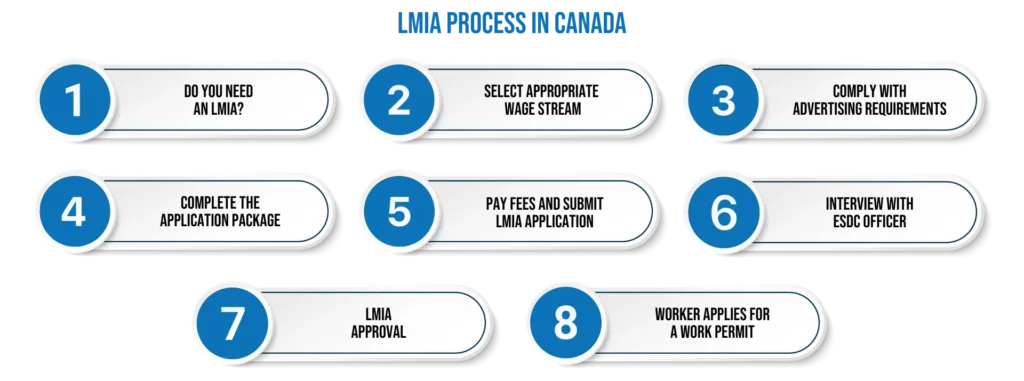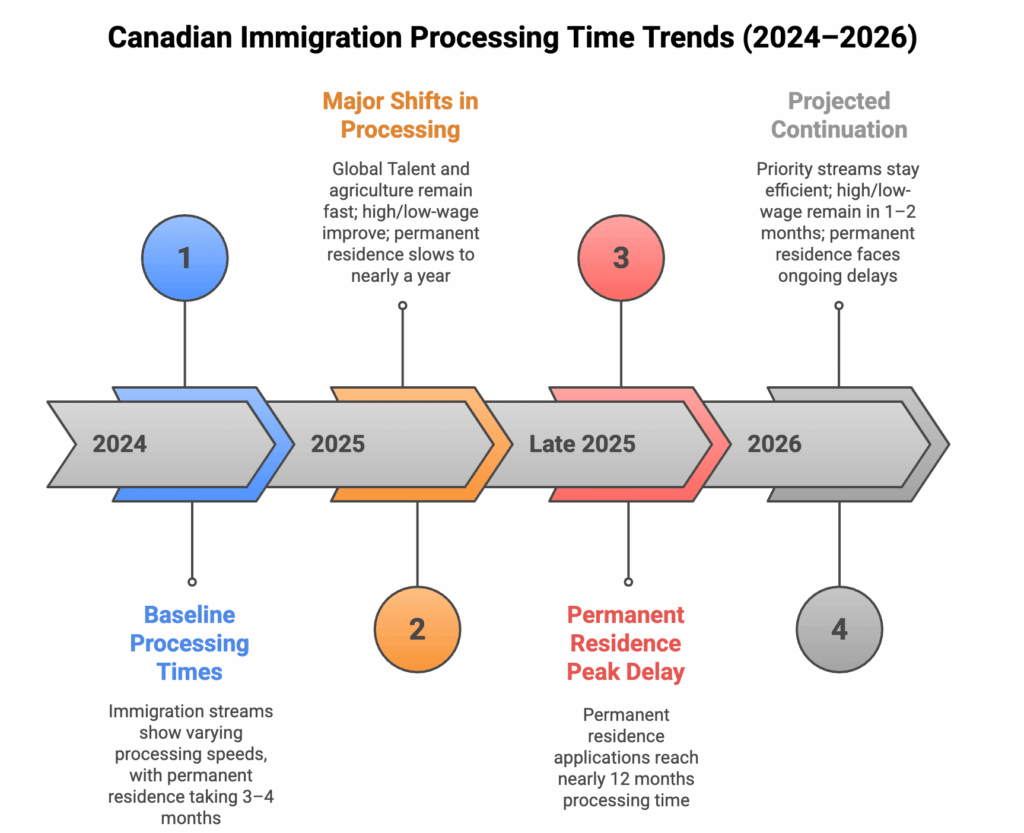Updated: November 6, 2025
If you’re a Canadian employer considering hiring someone from another country, you might be required to apply for an LMIA (Labour Market Impact Assessment) from Employment and Social Development Canada (ESDC) first. This article is here to help you understand everything about LMIA. We’ll explain how the process works, what you need to do, the paperwork involved, how much it costs, when to expect things to happen, and what rules you must follow. Plus, we’ll give you some tips to make your LMIA application successful and answer some common questions that Canadian employers often have.
What is an LMIA in Canada?
A Labour Market Impact Assessment (LMIA) is a document issued by Employment and Social Development Canada (ESDC). In many cases, an employer must obtain it before hiring a foreign worker. Through the LMIA process, ESDC reviews whether bringing in a foreign worker will have a positive, neutral, or negative effect on the Canadian job market. If the impact is considered positive or neutral, ESDC issues a positive LMIA, allowing the employer to proceed with hiring. This system helps ensure that hiring a foreign worker does not disadvantage Canadian workers.
However, not all employers need an LMIA. In some situations, you may be able to hire through the International Mobility Program, which allows certain categories of workers to come to Canada without an LMIA.
Canada’s Tech Immigration programs.
LMIA Types and Streams
Canadian employers can apply under different LMIA streams depending on the type of position and hiring needs:
-
High- and Low-Wage Positions – For a wide range of jobs, with the applicable process based on the provincial or territorial wage threshold.
-
Primary Agriculture Positions – To hire workers for farming, livestock, greenhouse, or other agriculture-related roles.
-
Applications to Support Permanent Residency – For skilled employees whose job offers support their permanent residence applications.
-
Global Talent Stream – For employers seeking unique skills or in-demand workers to help scale and grow their business quickly.
-
Caregiver Positions – To hire caregivers for children, seniors, or individuals with medical needs.
-
Foreign Academic Positions – For degree-granting post-secondary institutions to recruit professors, researchers, or academic staff.
How to Get an LMIA for Work Permit
The LMIA process depends on which stream you are applying under, but in general, it can be broken down into the following stages.
First is the recruitment phase, where employers are expected to make genuine efforts to hire Canadians or permanent residents before turning to foreign workers. Some streams, such as the Global Talent Stream, recognize critical shortages and may exempt employers from this recruitment step.
Next comes the LMIA application, where you prepare and submit all required forms, fees, and supporting documents. In many cases, employers may then be invited to an interview with an ESDC officer to clarify details about the job offer and recruitment efforts.
After this review, a decision is issued—positive or negative—on your LMIA application. If approved, your foreign worker can then use the LMIA to apply for a work permit to come to Canada.
LMIA Processing Times in 2026
Over the past two years, the processing times have shown both consistency and significant shifts depending on the stream. The Global Talent Stream has remained the fastest option, with average decisions coming in around 7–9 business days. The agricultural and seasonal agriculture (SAWP) streams have also been relatively quick, generally processed within 7–14 business days. Mid-range streams such as high-wage and low-wage positions have seen some improvement, averaging about 38–45 business days in 2025—faster than the 2–3 months often reported in 2024. By contrast, the permanent residence stream has become significantly slower, with processing stretching to nearly a year by late 2025, compared to 3–4 months in 2024.
Looking ahead to 2026, employers can expect these patterns to largely continue. Priority streams like Global Talent and agriculture are likely to stay efficient, while high- and low-wage applications may remain in the one-to-two month range. The permanent residence stream, however, is expected to face ongoing delays given current backlogs. Employers should plan ahead and ensure their applications are complete and well-documented, as thorough submissions remain the best way to avoid further delays.
LMIA Costs: What You Should Budget
When planning to hire through the LMIA process, employers should budget between $5,500 and $8,000 per hire, as several costs are involved. These may include:
-
Advertisement Costs: Posting on multiple paid platforms is recommended and can cost around $500–$600.
-
LMIA Application Fee: The government charges $1,000 per position.
-
Work Permit Fees: If you choose to cover your candidate’s application costs, expect an additional $480–$550 to account for the work permit fee, biometrics, and medical exam.
-
Legal Fees: Depending on the complexity of the case and the level of support required, professional fees typically range from $3,000 to $7,000.
For high-wage roles, employers must also submit a Transition Plan, which may add to the overall expense. Keep in mind that these estimates do not cover extra costs such as airfare for the employee’s travel to Canada.
Importantly, Canadian law requires employers to bear all LMIA-related expenses. It is strictly prohibited to recover these costs from foreign hires—either directly or indirectly. This includes recruitment charges, job orientation, First Aid training, or any other associated fees. Employers must also ensure that recruiters or third parties involved in the hiring process do not charge candidates under any pretext. Violating these rules can result in serious consequences, including reimbursement orders, suspension from the program, heavy fines, or even criminal prosecution.
Approval Rates for LMIA in 2025-2026
With changes making the LMIA program stricter, we are seeing officers apply far more scrutiny to applications, resulting in reduced approval rates.
In our experience, high-wage LMIAs tend to perform best, with approval rates remaining above 90%. The Global Talent Stream continues to be a reliable fast-track option, with approval rates above 95%. By contrast, low-wage applications are facing significantly higher refusal rates—often between 69% and 80%—especially in regions with higher unemployment.
The top three reasons for LMIA refusals today are:
-
Deficiencies in recruitment efforts – Officers are increasingly signaling that more must be done to recruit Canadians before turning to foreign talent.
-
Lack of genuine business need – ESDC officers are becoming more demanding in their review and now require stronger evidence that the role is essential to the employer.
-
Failure to meet program requirements – Even technical mistakes, such as misusing Job Bank’s job match feature or failing to provide sufficient supporting documents, can result in refusals.
In this stricter environment, employers must prepare exceptionally strong applications. Careful compliance with recruitment requirements, clear proof of business need, and complete documentation are more important than ever to secure a positive LMIA decision.
How to Identify the Correct NOC for Your LMIA Application
The NOC, known as the National Occupational Classification, is Canada’s way of organizing the different jobs that Canadians do in the job market. It gets updated every five years in collaboration with Statistics Canada to provide a standardized understanding of the labour market. The latest version of the NOC was released in 2021. Employers interested in hiring foreign talent should begin by choosing the appropriate NOC occupation. The NOC classification plays a crucial role in determining the prevailing wage and influencing ESDC’s assessment of local job opportunities, which ultimately impacts the outcome of your LMIA application. Furthermore, IRCC will use the NOC classification to understand employment requirements for your position and decide whether to approve your request for a temporary foreign worker. To identify the correct NOC for your position, follow the steps below:
-
Search the NOC: Visit NOC 2021 and search your occupation by title.
-
Review multiple NOC options: Based on our experience, in most instances, you’ll find several NOC occupation classifications to consider for each position. Given the extensive range of job titles in the 2021 NOC, along with considerable overlap among them, selecting the right NOC entails carefully assessing the lead statements in the NOC, the listed job duties, and the employment requirements. Do not just rely on the official job title when determining the most suitable NOC. It’s crucial to align your job duties and the employment requirements with the duties and the job requirements listed in one or more relevant NOCs.
-
Assess the local market conditions: Among other things, your NOC choice should consider the overall labour market situation for each NOC occupation classification in the particular geographic region. You should research the labour market situation for each potential NOC occupation (Job Bank Labour Market Information is a good starting point) and hopefully arrive at an NOC occupation classification that is an accurate reflection of the proposed job offer and where there also is a recognized shortage of local talent.
-
Confirm the minimum wage for the position: In addition to assessing the local labour market conditions, you must also ensure that the prevailing wage for your chosen NOC occupation classification is within your budget (see Determining the Prevailing Wage Rate below). Many employers set wages for foreign employees based on what others in their company earn or what the applicant agrees to. However, to get a positive LMIA, you must offer the prevailing wage rate to the foreign worker. This sometimes might mean paying your foreign talent more than your existing employees.
-
Ensure that your candidate meets the requirements for the NOC: Lastly, you must ensure that the proposed candidate satisfies the employment requirements for the proposed NOC occupation classification. While ESDC will generally not evaluate whether the foreign worker satisfies the employment requirements, the CBSA or Visa Officer who ultimately issues a Work Permit will no doubt perform this evaluation. There is nothing more frustrating than having your foreign worker’s application to work in Canada refused after you’ve gone through the hassle of securing a positive LMIA.
LMIA: Wages to Your Foreign Talent
As an employer hiring a foreign national through this program, you must ensure the individual is paid at least the prevailing wage for the specific job and location—or the same wage you already pay current employees in comparable roles, if that is higher. To determine the prevailing wage for your position, follow these steps:
-
Identify the correct NOC code for the occupation.
-
Go to the Job Bank website and, under the “Explore the Market” section, select “by wages.” Enter the 4-digit NOC code.
-
Choose the relevant geographic region. If no local data is available, use the provincial median wage, and if that is also unavailable, default to the national median.
The median wage is the minimum standard that must be met. In some cases, particularly for senior roles, ESDC officers may expect salaries above the median. If you are unwilling to meet at least the prevailing wage, the application will not succeed. Alternative compensation, such as commissions, cannot replace this requirement—your base salary must still align with the applicable median rate. Employers are also responsible for reviewing prevailing wages regularly to ensure foreign hires continue to be paid at or above the required level throughout their employment.
How to Draft a Job Posting for an LMIA Application
A well-prepared job posting is one of the most important parts of a successful application under the Temporary Foreign Worker Program. Many employers make the mistake of writing postings only with their own hiring needs in mind, but it’s essential to follow Employment and Social Development Canada’s strict requirements. If your posting does not meet program standards, your application may be refused for “insufficient recruitment efforts.”
The key is to balance your company’s needs with the instructions set out by ESDC and Immigration, Refugees, and Citizenship Canada. A strong posting should clearly reflect the role while demonstrating that local candidates have been given a fair opportunity to apply.
Every job posting must include the following details:
-
Company name and business address
-
Job title
-
Job duties – specify tasks for each vacancy; avoid simply copying from the NOC description
-
Employment terms – e.g., permanent, temporary, or project-based
-
Language requirements
-
Wage information – include base salary, raises, bonuses, or performance pay; minimum wage offered must meet or exceed the prevailing rate
-
Benefits offered (if applicable)
-
Work location(s) – list city, town, or local area
-
Number of positions available
-
Employer contact details – email, fax, or mailing address
-
Skill requirements – education, credentials, and work experience
To strengthen your application, accompany the posting with a detailed job offer letter that reinforces compliance with program requirements and provides additional clarity to both ESDC and potential candidates.
How to Advertise Your Position Effectively
When recruiting through the Temporary Foreign Worker Program, the first step is to register an employer account on Job Bank. All job ads must be posted on Job Bank (or the provincial/territorial equivalent) for at least four consecutive weeks and must remain active until your application is decided. Setting up a Job Bank account can take around two weeks, and an additional 3–5 business days for your ad to go live. Do not begin advertising elsewhere until your Job Bank posting is active.
Once your ad is live on Job Bank, you can expand to other platforms. Employers are required to use at least two additional sources, but posting on three or four more provides a safety net—if one source is deemed unacceptable, the others strengthen your file. In our practice, we typically advertise across five platforms, including Job Bank. It is also critical to target underrepresented groups such as Indigenous persons, vulnerable youth, newcomers, and persons with disabilities, as Service Canada now applies stricter expectations to ensure inclusive recruitment. Advertising sources should be chosen strategically, ensuring they align with the occupation and reach candidates with the right skill set, education, or experience.
Recruitment strategies may include:
-
Print media – national or provincial newspapers, professional journals, or association newsletters.
-
General employment websites – Indeed.ca, Glassdoor.ca, LinkedIn, Eluta.ca, Workopolis, Monster.ca, etc.
-
Occupation-specific websites – industry-focused boards for fields like accounting, engineering, education, marketing, or biotechnology.
When diversifying your efforts, avoid overlapping audiences. For example, do not use Workopolis and Monster at the same time, or both Craigslist and Kijiji, as they target the same demographic.
A sample multi-platform recruitment plan could include:
-
Job Bank – mandatory (free)
-
National job board – e.g., Indeed.ca, Glassdoor, or Eluta.ca ($200–$600 for 4 weeks)
-
Occupation-specific platform – e.g., company website, professional journals, or specialized websites
-
Backup posting – e.g., Allstarjobs.ca ($50 for 90 days)
-
Targeted group site 1 – e.g., Newimmigrantjobs.ca ($50)
-
Targeted group site 2 – e.g., Aboriginaljobs.ca ($117 per posting)
Tips for a strong advertising campaign:
-
Maintain proof of advertising – All postings must run continuously for four weeks with no gaps. Collect weekly evidence (screenshots with dates and timestamps) to prove compliance. Even a one-day gap can jeopardize the application.
-
Renew postings on time – If your Job Bank ad is about to expire, extend it promptly to avoid gaps.
-
Document consistently – Some websites refresh postings automatically, which can make ads appear shorter than four weeks. Weekly screenshots prevent this issue.
By carefully planning and documenting your recruitment, you can show Service Canada that you made a genuine effort to hire domestically before turning to international talent.
How to Demonstrate Talent Shortage for Your LMIA Application
-
Step 1: Track applications: Record the total number of Canadian or permanent resident applicants.
-
Step 2: Screen top candidates: Select the top 10-15 candidates and conduct short telephone screenings. Document the date and time of each call.
-
Step 3: Hold interviews: Invite the top three candidates for formal interviews. If they are not suitable, interview two or three more from your shortlist.
-
Step 4: Understand flexibility: Hiring a local candidate does not stop you from proceeding with your application. A positive decision is valid for 6 months and can serve as a backup if the local hire leaves or more roles open up.
-
Step 5: Keep thorough records: Maintain detailed notes and evidence of all recruitment efforts. Strong documentation strengthens your case and reduces refusal risk.
How to Submit Your LMIA Application
To apply for an Labour Market Impact Assessment, employers must collect and submit various documents to ESDC, which can now be completed online using the ESDC portal for employers. The specific documents required vary depending on the LMIA stream (e.g., high-wage, low-wage, agricultural, caregiver, etc.), but generally, the required documents include the following: Every positive LMIA application includes application forms, supporting documents, and payment of an LMIA processing fee unless exempted. An LMIA application will always occur under specific streams depending on the nature of the job.
-
LMIA Application Form: A completed and signed application form for the specific LMIA stream you are applying for.
-
Business Legitimacy Documents: Documents that prove the legitimacy and legal status of your business, such as a business license, incorporation documents, and tax documents.
-
Job Offer Letter: A detailed job offer letter to the temporary foreign worker outlining job duties, wages, conditions of employment, and other relevant details.
-
Recruitment Efforts Documentation: Evidence of job advertisements across various platforms (e.g., Job Bank, other job boards, print media).
-
Transition Plan: For high-wage positions, a plan detailing how the employer intends to reduce reliance on temporary foreign workers in the future.
-
Processing Fee: $1,000 per worker, required for most types of LMIAs.
-
Union Consultation (if applicable): If the job is in a unionized position, proof of consultation with the union.
Additional Documents for Specific Streams: Depending on the LMIA stream, additional documents may be required. For example, agricultural and low-wage LMIA streams have specific requirements regarding housing arrangements and transportation plans for temporary foreign workers.
How to Prepare for Your Interview with an ESDC Officer
An interview with an ESDC officer is a critical step in the application process. Officers use this meeting to verify your business details, assess your recruitment efforts, and confirm that hiring a foreign national will not negatively impact the Canadian labour market. Preparation is key.
Who should attend?
Select someone in your company who understands your operations, staffing needs, and recruitment history. They should be ready to answer questions about the business and the role being filled. Having your lawyer present is also recommended—they can clarify legal points and ensure your responses are accurate and consistent with program requirements.Documents to have ready
Bring key company details (legal name, CRA business number, location, operating history), proof of recruitment (ads, resumes received, interview notes), and evidence of business need (financials, growth plans, or continuity concerns if the role remains vacant).Questions you can expect
ESDC interviews generally last around 40 minutes and cover three main areas:-
Business Information
-
Confirm business name, CRA number, location, number of employees, and operating status.
-
Describe your business activities and, if relevant, how COVID-19 affected operations.
-
-
Recruitment Efforts and Labour Shortage
-
How many Canadians applied?
-
Why were they not hired (lack of skills, experience, or training potential)?
-
How does this role address a genuine labour shortage?
-
-
Impact of Hiring a Foreign National
-
How will hiring benefit your company (job creation, retention of Canadian staff, skill transfer)?
-
What training or succession plans are in place for Canadian employees?
-
What are the terms of employment (hours, wage, benefits, vacation)?
-
Example questions:
-
“How will this role lead to job creation or retention for Canadians?”
-
“Why could you not hire a Canadian or permanent resident for this position?”
-
“What specialized skills or knowledge does this candidate bring that are not readily available in Canada?”
-
“What is your plan for training Canadians to eventually take over this role?”
Pro tip: Practice your answers in advance with your lawyer. Keep responses factual, concise, and aligned with your documentation. The officer’s goal is to determine whether there is a real need for a foreign hire and whether your recruitment efforts were genuine.
-

How to Support Your Temporary Foreign Worker’s Application to Work in Canada
How to Support Your Candidate’s Work Permit Application
Securing a positive Labour Market Impact Assessment is only part of the process —IRCC has the final say on the work permit. To avoid refusal, provide a clear job offer that sets out the duties, terms, conditions, and wages.
Strengthen the application with a letter of support explaining why the candidate is qualified, how you assessed their skills, and what measures are in place to help them succeed (e.g., training, bilingual staff, or other supports).
These steps not only improve approval chances but also show your commitment to the candidate’s smooth integration into your business and Canada’s workforce.
LMIA: Frequently Asked Questions
Below, you will find answers to the most common questions about labour market impact assessment.
Q: Can any employer apply for an LMIA?
No. Employers in certain industries (e.g., strip clubs, escort services, erotic massage) are automatically ineligible. Employers on IRCC’s ineligibility list, those owing penalties, or those found non-compliant also cannot apply.
Q: Can my LMIA application be refused before it’s even processed?
Applications may be refused due to ministerial or public policy rules. For example:
-
If you request too many low-wage positions at one location (above the 10% or 20% cap).
-
If the job is low-wage and located in an area with an unemployment rate of 6% or higher.
-
If the position requires a live-in caregiver arrangement.
-
If you had an LMIA revoked in the past two years.
Q: What are the limits for low-wage positions?
Low-wage applications are subject to stricter rules than high-wage ones. Employers must demonstrate more rigorous recruitment efforts to show that no Canadians or permanent residents are available for the role. In addition, as of October 2025, work permits for low-wage positions are typically issued for a shorter duration—one year only, compared to longer terms for high-wage jobs.
Most employers cannot fill more than 10% of their workforce at a single site with low-wage foreign hires. In certain essential sectors—such as construction, food manufacturing, hospitals, and residential care facilities—the cap is higher, at 20%. Some low-wage roles in Montreal and Laval are also temporarily ineligible.
Q: How does the unemployment rate affect my application?
If your worksite is in a Census Metropolitan Area (CMA) with an unemployment rate of 6% or higher, applications for low-wage positions (below the provincial median wage) may be refused. You must check the postal code to confirm which CMA applies.
Who Will Pay for LMIA in Canada?
Employers are responsible to cover all expenses associated with the Labour Market Impact Assessment application process. Under Canadian legislation, it is explicitly forbidden for employers to transfer any of these costs to foreign workers, either directly or indirectly. It is also important to ensure that recruiters and any third parties involved in the recruitment of foreign workers refrain from imposing any charges on these workers for any reason. Breaching this rule can result in serious consequences, such as the obligation to refund fees to the worker, exclusion from the foreign worker program, substantial fines, and the possibility of facing legal action.
What if my foreign worker quits or underperforms?
When a foreign employee resigns or underperforms, you should handle the situation just as you would with any Canadian worker—using the same performance management and termination processes applied across your workforce. The key difference is the additional reporting obligation when a positive LMIA was used to hire the individual.
If the employment ends, you must notify both the local ESDC office and IRCC in writing. Your notice should include the employee’s positive LMIA number. Once submitted, wait for confirmation letters from both agencies and keep these documents in the employee’s file. This ensures compliance with program requirements, protects your business, and upholds the rights of the foreign worker.
How Can I Get an LMIA From an Employer?
If you are a foreign national and have a genuine job offer from a Canadian company, you do not apply for the LMIA yourself. It is the employer’s responsibility to submit the application and obtain approval before you can apply for a work permit.
Keep in mind that in Canada it is illegal to pay for a job offer, an LMIA, or any type of recruitment fees. If anyone asks you for money in exchange for a job offer, this is fraud. You risk losing your money and could even be banned from entering Canada for engaging in illegal activity. Remember: if something sounds too good to be true, it usually isn’t true.
Can I Give a Job Offer to Myself and Apply for an LMIA?
Yes, this was once possible under the Owner-Operator LMIA program, but that program was cancelled in April 2021. Today, self-employed foreign nationals are subject to the same business legitimacy requirements as any Canadian employer. This means you must generally demonstrate that your Canadian business has a physical office, active operations with employees and customers, and has been operating in Canada for at least one year before applying.
How Long Is the LMIA Work Permit Valid For?
Work permits that require LMIA are usually issued for 1-2 years. The length of the work permit will largely depend on the work permit type, the job characteristics, and the employment location. The Canadian government can issue work permits that are either longer in duration or shorter, depending on one’s case.
How Can I Get an LMIA Work Permit?
To get an LMIA work permit, your Canadian employer must first apply for the LMIA with the ESDC. If the application is approved, the foreign worker can initiate the application process for a work permit. The foreign worker must meet all the requirements for a work permit to work in Canada. LMIA approval is not enough to bring a foreign worker to Canada.
Is LMIA Free?
LMIA process is not free. If a company applies for an LMIA, they will have to pay $1000 per application. However, there are exceptions where employers may pay less. These are dependant on the salary of the position as well as the immigration program.














